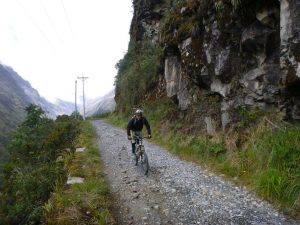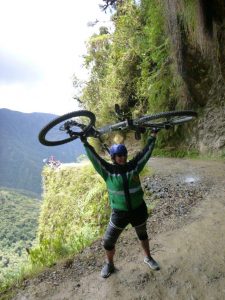Since I spend most of my time cycling on road bikes, on roads, in European countries. It seemed like a great idea that my first introduction to downhill mountain biking should be cycling the infamous Death Road in Bolivia. Sorry mum!
I was staying La Paz, at 3640m it’s one of the highest cities in the world. Just walking up a hill takes your breath away! I met my guide, Carlos, in the city, loaded up some bikes and off we went, up even higher into the Andes mountains.

At the top of a mountain pass (nearly 5000m in altitude), we donned a few layers of warm clothing and then a few more of protective clothing. There was the offer of a full-face helmet, as well as protective, trousers, knee pads, elbow pads, jacket and gloves. I was riding a full-suspension Trek mountain bike; it looked the part and I was excited to do a different kind of cycling. After a few practice loops and remembering that the brakes were the opposite to the UK (!), we were ready to go. Just one more thing; first we needed to make an offering to the Pachamama. The Pachamama, roughly translated as Mother Earth, is the pre-Incan god still revered by many in Bolivia and also Peru. We tipped some neat alcohol on our bikes, on the floor as an offering to the Pachamama (who would protect us on our journey down) and then drank a small sip ourselves, call it Dutch courage.
The first section was a nice ease into getting to know the bike and its braking distance. This part of the road was smooth tarmac and it was downhill all the way. Once I’d got the measure of my bike, I was getting down in a nice aero position, tailing my guide the whole way. We picked up some serious speed, overtaking the few and far between trucks that still use that part of the road.
We regrouped after a long, sweeping right-hander and then took an unpaved road to the side of a tunnel, where bikes weren’t allowed to go. Unpaved is an understatement and this was my first introduction to cycling on some seriously uneven terrain. The road was mostly dust and gravel with rocks and boulders scattered it. I soon learnt which rocks the bike could handle going over and which might bring me down. “Watch out for babies’ heads,” Carlos would shout over his shoulder – that means a rock that was too big to bounce over – you can guess the size.

After a brief respite back on the tarmac, we took a left turn onto the proper Death Road. Luckily this is now closed to normal traffic, so the only vehicles are locals and cycle support vehicles. This is the start of the Camino de la Muerte (Death Road). Starting at La Cumbre Pass (at 4850m), it descends all the way down to the town of Coroico (1200m) – that’s a lot of elevation loss!

The road was bumpy as hell, single track and more rocks and stones than gravel. It’s not surprising that there used to be an average of 250 deaths per year on here due to careless driving, bad weather and the sheer drops around blind bends. Whilst some cyclists have died on here, it all seemed to be within my comfort zone, just about! Navigating our way down was about 80% freewheeling and managing the brakes, 10% pedalling, 5% skidding around tight bends I’d misjudged, 3% bouncing over things and 2% clinging on for dear life.
We stopped many times for pictures and safety briefings about the technical aspects of the next bit of road. The more altitude we lost, the hotter and hotter it got. Little waterfalls sprayed us as we zoomed underneath, which was nice and refreshing, but soon we needed to stop and put some layers into the support van.

The views were incredible, but we barely had time to appreciate it as I was too busy concentrating on switching from one line to another, cliff face on one side, sheer drop on the other!
About halfway down we stopped at a small cross on the road. This is where, our guide told us, an over-crowded bus had slid over the edge, taking with it more than 100 men, women and children.

A sobering thought as we continued to make our way down, going faster and faster as I became more confident on the bike. Reminding myself not to get too cocky, I pumped the brakes a little more for the final few hairpins and made it to the bottom with a clean run – thanks Pachamama! 🙂
In summary:
This was an amazing and exhilarating ride, although it does have some pretty big risks involved. So, make sure you go with a professional guide or tour operator and that the equipment they give you is up to standard. Like we tell all of our riders: it’s not a race and if you ride within your limits, you’ll have a great time.
Topography – downhill all the way.
Terrain – the most uneven and rocky surface we’ve ever encountered – keep your wits about you at all times!
Ability – not for the faint-hearted. Great for confident cyclists and downhill riders.
